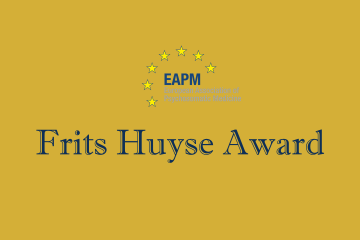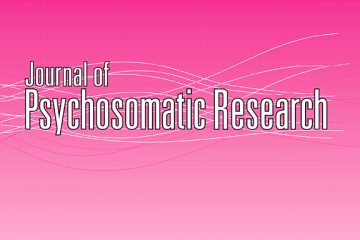The Editor’s choice December 2020
written by Jess G. Fiedorowicz, Editor-in-Chief, Journal of Psychosomatic Research, Professor and Senior Research Chair in Adult Psychiatry, University of Ottawa, Head and Chief of Mental Health, The Ottawa Hospital Scientist, Ottawa Hospital Research Institute, December 2020

Jess Fiedorowicz, JPR’s Editor-in-Chief
The Editor’s Choice –
Our final Journal of Psychosomatic Research Editor’s Choice of 2020 appropriately engages an important issue related to the dreaded topic of the year, the COVID-19 pandemic. “Stay-at home circumstances do not produce sleep disorders: an international survey during the COVID-19 pandemic” assessed the impact quarantine and stay-at-home conditions on anxiety-related insomnia and other sleep disorders (1). The journal has been inundated with COVID-related submissions, many with small samples and most using a cross-sectional design wherein it is impossible to discern to what degree the results are indeed related to some aspect of the pandemic. This problem is not unique to this journal. We partnered with a group of investigators conducting a living systematic review on the topic (2), the results of which can be found online at https://www.depressd.ca/covid-19-mental-health. They have had to review an excessively large swath of studies to find a few designed appropriately to answer their questions. Against a backdrop of such studies and with overall journal submissions more than 50% from last year, I have experienced a different sort of COVID fatigue. This paper led by senior and corresponding author Michael Shterenshis was distinctly different than these modal studies. The study was international and prospective, analyzing 14,000 subjects from 11 countries with stay-at-home orders. Corresponding author Michael Shterenshis summarizes the article in the following:
During COVID-19 pandemic March-May lockdowns, we analyzed 14,000 subjects with average stay-at-home of two months. For the majority, the difference in the sleep duration between weekdays and weekends disappeared; most of the participants discontinued using alarm clocks and slept up to 1:30 h longer. Only 0.5% of participants indicated insomnia after two months of stay-at-home. During such situations, sleep duration, timing of sleep, and napping habits significantly differ from those of daily routine and most humans sleep longer than in a schedule-dependent ordinary life. The anxiety-induced insomnia is extremely rare if a healthy individual is already in the stay-at-home situation.
With all the conversation surrounding adverse psychological effects of the pandemic, including anxiety-related insomnia, what a remarkable conclusion. The authors did not find worsening sleep for those in stay at home conditions. If anything, several sleep parameters improved.
Arguably the most interesting piece of this study was that it was executed by two high school science research departments. Corresponding author Michael Shterenshis was kind enough to expand upon the intriguing background for this study. The entire concept for the study was developed at Alexander Muss High School in Israel (AMHSI), which is affiliated with the Alexander Muss Institute for Israel Education in Hod HaSharon, Israel and at Milken Community High School in Los Angeles, California, in the United States. Both schools have Science Research Departments. Of the 1,100 students who attend AMHSI, only about 10-12 students are selected for real-world research activities. Authors Jacob Burger, Aidan Leit, and Noa Buchris, all from the United States, are alumni and others involved are listed in the acknowledgements. For Milken Community High School, the students can select science research as a subject in addition to more traditional science classes. This group was listed as the second author on the paper as “Milken Research Team” and some of these students and teachers are in the acknowledgements. When the pandemic arrived and both schools were about to be locked down, there were lengthy discussions on what sort of research could be performed in lock-down. It was decided to study sleep changes in healthy individuals being caught in stay-at-home conditions and the entire concept, methodology, and logistics were fully developed in early March. An initial target was set for 500 participants per research tool, but the study quickly grew larger than initially anticipated and ended with 14,000 participants. What an accomplishment by this team of students, their teachers, and collaborators!
The most notable strength of the study was its prospective design with assessments before, 14 days after, 1 month after, and 2 months after stay-at home. The authors developed a sleep-wake patterns questionnaire and validated it using a daily log. Agreement between logs and the questionnaire was high. On average, the cohort stayed at home for 62 days. Total sleep time prior to stay-at-home averaged 7 hours and 36 minutes per day. This jumped to 8 hours and 52 minutes two weeks into stay-at-home and settled on 9 hours and 10 minutes at the end of stay-at-home. Sleep discrepancies between weekdays and weekends also disappeared and most participants stopped using alarm clocks (use of alarm clocks dropped from 74% to 21%).
Another strength of this study was its representativeness. The authors surveyed men and women ranging in age from 15 to 60 in 11 countries: the United States, the United Kingdom, Australia, Canada, Israel, Germany, France, Ukraine, Russia India, and Uzbekistan. The results are almost certainly generalizable. While it may seem all the more impressive that this rigorous study was conducted by teams of high school students, corresponding author, Michael Shterenshis shared a simple slogan that really resonated with me — “Research is research and cannot be divided into ‘high school,’ ‘undergraduate’ or ‘post-doc.’”
While looking at just one aspect of quarantine or stay-at-home orders, sleep, undoubtedly doesn’t capture the whole experience of quarantine. The study does confirm that the ever-so-important sleep that we at least should spend around 1/3 of our lives in does not deteriorate under stay-at-home conditions. This rigorous study compelling provides another silver lining on the otherwise dark times of the pandemic. That which takes aware some freedoms may not necessarily take away our sleep. Opponents of stay-at-home orders may cite other health concerns, often mental health concerns, to counter public health measures to stop infection spread. This study takes away any argument that stay-at-home conditions are likely to worsen sleep or insomnia. If anything, those staying at home are more likely to sleep unfettered.
REFERENCES
- Amhsi Research Team, Milken Research Team, Roitblat Y, Burger J, Leit A, Nehuliaieva L, et al. Stay-at-home circumstances do not produce sleep disorders: An international survey during the COVID-19 pandemic. J Psychosom Res. 2020;139:110282.
- Thombs BD, Bonardi O, Rice DB, Boruff JT, Azar M, He C, et al. Curating evidence on mental health during COVID-19: A living systematic review. J Psychosom Res. 2020;133:110113.

See this link fyi: https://www.journals.elsevier.com/journal-of-psychosomatic-research/editors-choice/stay-at-home-circumstances-do-not-produce-sleep-disorders



0 Comments